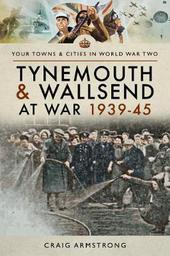
|
Tynemouth and Wallsend at War 1939 - 1945
Paperback / softback
Main Details
| Title |
Tynemouth and Wallsend at War 1939 - 1945
|
| Authors and Contributors |
By (author) Craig Armstrong
|
| Physical Properties |
| Format:Paperback / softback | | Pages:221 | | Dimensions(mm): Height 234,Width 156 |
|
| Category/Genre | Second world war
Local history |
|---|
| ISBN/Barcode |
9781473867543
|
| Classifications | Dewey:940.5342879 |
|---|
| Audience | |
|---|
| Illustrations |
50 illustrations
|
|
Publishing Details |
| Publisher |
Pen & Sword Books Ltd
|
| Imprint |
Pen & Sword Military
|
| Publication Date |
19 March 2018 |
| Publication Country |
United Kingdom
|
Description
Tynemouth and Wallsend were key communities in the national war effort despite their relatively small size. Located on the key East Coast they played a significant military and civil role in the war. Tynemouth was situated at the key entry to the strategically important River Tyne and was well defended against enemy attack with several forts and other measures in place. The scenic seaside town saw a large military build-up with several different army and naval units rotating through the area to man defences and to train whilst the local Home Guard unit was voted one of the best in the country and was asked to give a radio broadcast on its methods (despite some comic accidents along the way). Wallsend, a largely urban industrial community, was home to key wartime industries with its shipbuilding yards (including Swan Hunters) building and repairing huge numbers of vessels, both naval and merchant, throughout the war. This made the town a significant target for the Luftwaffe and several determined raids were made which inflicted heavy casualties, especially during 1941. The area also hosted a large number of heavy and light industrial works which made significant contributions to the war effort. The fishermen of the North Shields fishing fleet also played a dangerous role during the war (many, including one of the author s grandfathers served in the Royal Naval Reserve) when supplying fresh fish, already a dangerous task, to a near-starving wartime population was made more dangerous through enemy action. The book also looks at the considerable contribution made by the men and women who volunteered for the ARP and Civil Defence Services. The heavy raids resulted in great loss of life, including the most deadly single attack outside of London when over 100 people were killed when a North Shields shelter took a direct hit in 1941, and the men and women of the emergency services were faced with horrifying scenes (the author s other grandfather was a regular fireman and ambulanceman who had a particularly lucky escape when his fire engine was blown into a shell crater during a raid) which they had to overcome and work through. No member of the community was left untouched by the war whether they were evacuees (the author s father was one of them), workers, servicemen or just civilians struggling to maintain a home in wartime Britain. AUTHOR: Born and bred in Northumberland, Dr Craig Armstrong is an experienced historian, with a special interest in the history of the North East of England and Scotland. He has expertise in nineteenth and twentieth-century history, with a particular focus on social and military history. Dr Armstrong currently splits his time between working as a freelance author and researcher on all things North Eastern and Scottish and teaching part-time at Newcastle University. 50 illustrations
Author Biography
Born and bred in Northumberland, Dr Craig Armstrong is an experienced historian, with a special interest in the history of the North East of England and Scotland. He has expertise in nineteenth and twentieth-century history, with a particular focus on social and military history. Dr Armstrong currently splits his time between working as a freelance author and researcher on all things North Eastern and Scottish and teaching part-time at Newcastle University.
|